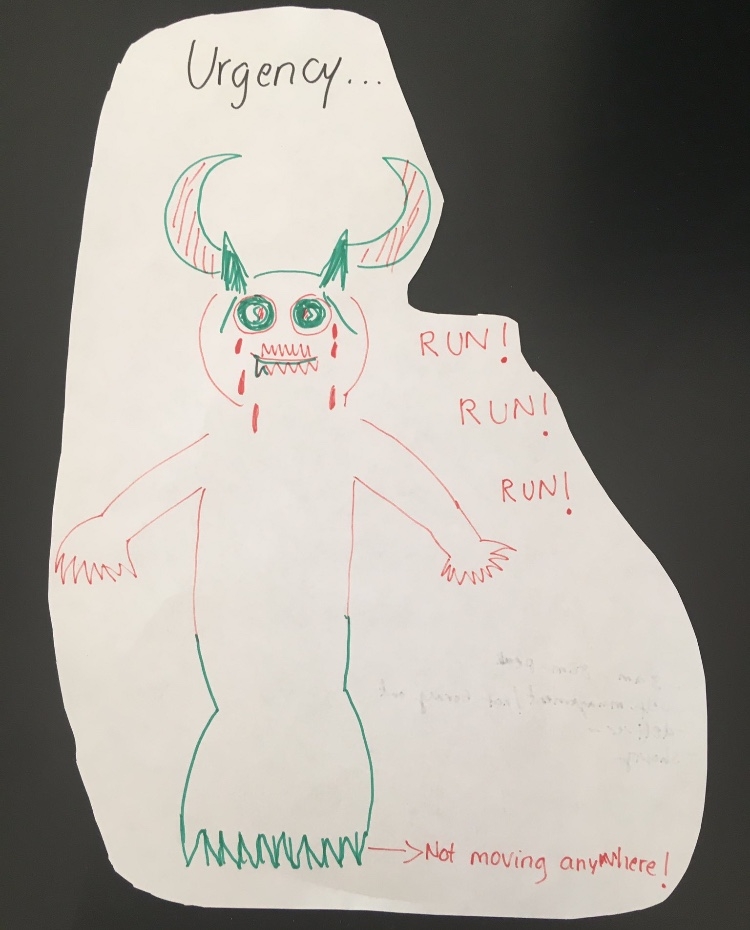
As 2021 comes to a close, here’s a question for your year-end reflections: What is your relationship to urgency? What is constant urgency costing you?
I believe igniting our creativity is vital for transformative change, and especially for narrative change in the international aid and philanthropy sector. It requires all of us to identify ourselves as communicators and to take bigger “creative risks.” I also believe our sector’s sense of urgency impedes this.
Urgency surrounds us and yet we know that our minds need time to wander, to look at issues from all sides, and let our creativity flow.
Play in the form of art-making (of all kinds) “stretches us, prepares us for taking risks and new experiences. It acknowledges our broken idealistic hearts, our confusion and burnout and loss – all while grounding us in what is possible – right here in our own bodies, with our own hands and feet and minds.
During a gathering of #Globaldev Communicators Connect earlier this year, which I co-host with Joan Okitoi-Heisig in the Healing Solidarity Collective each month, we risked inviting our fellow global development professionals to accompany and generously witness each other’s creative process. What will happen if we don’t take ourselves so seriously all the time? We asked them first to imagine “urgency” as a monster, demon or beast and to draw this monster. The aim was not to create a masterpiece, but rather capture the emotions that urgency brings up for them.
We then asked participants to write a poem to the Urgency Monster or about a feeling that the monster brings up for them using a poem template. Here was mine:
As I face the urgency monster, tension washes over me.
It is the color orange, like the edge of a bush fire.
I hear chugging in my ears, like a train barreling down the tracks.
I taste metal, like aluminum foil between my teeth.
I smell sulfur and gunpowder, like the smoke that lingers after the fireworks have gone off.
I see my keyboard, like a full inbox taunting me.
I feel rigid, like shoulders, jaw tight.
I want to keep going and not stop.
But my body screams, and so I must.
As we made art together on Zoom, we noticed and navigated the tension between having to “get things done” at work and the real need for more playfulness and joy in our work. In “trusting the process” of creating art together, we learned to learn, to show up with a quality of non-judgment, and to embody what we know to be true. In this witnessing, we reinforced the value of community.
This was also a chance to reinforce that urgency is not just a barrier to fuller storytelling. Urgency is also a tool of control, of maintaining the status quo, and is a characteristic of white supremacy culture within organizations, as described by anti-racism trainers Kenneth Jones and Tema Okun as “[making] it difficult to take time to be inclusive, encourage democratic and/or thoughtful decision-making, to think long-term, to consider consequences.” They go on to describe that urgency “frequently results in sacrificing potential allies for quick or highly visible results”, which is “reinforced by funding proposals which promise too much work for too little money and by funders who expect too much for too little.”
This is why urgency is something which we must learn to resist in our sector, our organizations, our teams, and our selves, and so that our creativity as communicators is no longer impeded by always having to get things done now, now, now!
And it’s sooooo hard!
So how do we do it? Participants shared their insights and ideas about when they might be more creative, which were tied to our ways of working:
- The importance of time spent with colleagues that did not have a structured agenda
- Taking off blocks of times at key “productive” times of the day for “deeper thinking”, not just email, tasks, or meetings
- Time set aside specifically for collaboration and development of ideas with colleagues
- When people are exposed to new technology or ideas and it’s opening their minds
- For people with uteruses, intentionally pausing when they are on their period
- When people say “no” or renegotiate with their bosses when new tasks are assigned
- When people pay attention to their “self-talk” and notice/interrupt patterns of pressure to deliver or guilt for not “producing”
Perhaps most important for us all to consider next, what could happen differently if we could orient ourselves to the idea of “enough” time? Let’s imagine what else could happen in our organizations then!
***
Related Posts
Want to make aid better? Let us play!

